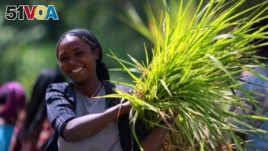Sep 9, 2017
Hunger is a result of poverty, but it also causes poverty. People who do not have sufficient food and nutrition are less able to escape from poverty. In many countries women, although they do much of the farming, lack access to training, credit or land. Conflict, poor or corrupt management of natural resources, displacement of small farmers by natural disasters; and financial and economic crises that eliminate jobs at the lowest levels, all contribute to creating conditions that push the poorest into hunger.
To break this vicious cycle, the United States launched, in 2010, the Feed the Future Initiative, which aims to reduce global hunger, poverty, and undernutrition by focusing on smallholder farmers, increasing investments in agriculture and supporting country-owned plans for improving food security and nutrition while generating opportunities for economic growth and trade.

Support for farmers improves household incomes and builds food security.
Back then, the U.S. Government selected 19 countries in Africa, Asia and Latin America to participate in the initiative, based on 5 criteria. Since 2010, Feed the Future has helped 9 million people living in the participating countries, pull themselves out of poverty.
The passage of the U.S. Global Food Security Act of 2016 endorsed Feed the Future's approach and ushered in a new era of U.S. Government global food security investment. A new, corresponding global food security strategy developed by the U.S. Government is guiding Feed the Future's work as the initiative enters its second phase.
On August 31st, USAID Administrator Mark Green announced that Bangladesh, Ethiopia, Ghana, Guatemala, Honduras, Kenya, Mali, Nepal, Niger, Nigeria, Senegal, and Uganda were selected to participate in this new phase of Feed the Future.
“With the selection of these 12 countries, the second phase of Feed the Future will be focusing its efforts on promoting long-term, sustainable development that brings partners together to help people harness the power of smart agriculture to jumpstart their local economies and lift themselves out of poverty,” said Administrator Green.
“By equipping people with the tools to feed themselves over the long term, Feed the Future is addressing the root causes of hunger and poverty. This long-term investment builds communities that are more resilient to drought, famine and other natural disasters, and less dependent on emergency food assistance.”